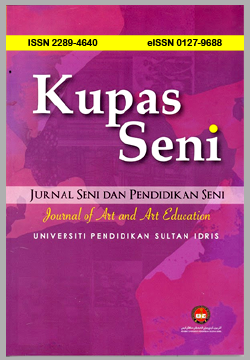Comparison Analysis of Sound of Through Notation ‘A’ Produced by Angklung Instruments Which are Made From Different Species of Bamboo
Analisis Perbandingan Suara Melalui Notasi ‘A’ Dihasilkan oleh Instrumen Angklung yang Dibuat Dari Spesies Buloh Yang Berbeza
DOI:
https://doi.org/10.37134/kupasseni.vol9.1.3.2021Keywords:
Angklung, Bamboo, Sound Analysis, Adobe AuditionAbstract
Angklung is a traditional musical instrument that originated in Indonesia and later been established in Malaysia since the 1930s. The tube is the most important part of the angklung. Almost 100% of the material used in making/producing the angklung instrument is from bamboo. There are 3 types of bamboo species commonly used in producing the angklung. Mostly use is the Gigantochloa atroviolaceae widjaja species of bamboo and two option is Gigantochloa scortechinii and Bambusa vulgaris. In this study, the results of the note ‘a’ sound recordings from all three species were performed by ‘kerulung’ technique and the comparison between the three species was carried out through frequency sound analysis using: audio waze, spectrogram and fast Fourier transform (FFT) using adobe audition software. The results showed a character difference through the timber element of the species of bamboo material to the sound analysis.
Downloads
References
Amatyakul, P. (2019). Century of the Angklung Journey and Its Establishment in Thailand. International Journal of Creative and Arts Studies, 6(1), 61–68. https://doi.org/10.24821/ijcas.v6i1.3275
Anokye, R., Bakar, E. S., Abare, A. Y., Kalong, R. M., & Muhammad, A. (2014). The different in density along the bamboo culms of Gigantochloa scortechinii and Bambusa vulgaris, International Journal of Emerging Technology and Advanced engineering 4(10), 638-643.
Arifin, P., & Pribadi, I. (2019). Modeling of angklung to determine its pitch frequency. Acoustical Science and Technology, 40(3), 178–185. https://doi.org/10.1250/ast.40.178
Bhat, I. U. H, Mustafa, M.T, Mohmod, A. L., & H. P. S. Abdul Khalil. (2011). Spectroscopic, Thermal, and Anatomical Characterization of Cultivated Bamboo (Gigantochloa Spp.). Bioresource. 6(2), 1752-63.
Bisht, P., Pant, M., & Kant, A. (2010). In vitro propagation of Gigantochloa atroviolaceae Widjaja through nodal explants. Journal of American Science, 6(10), 1019–1026..
Budi, E. M., Suhada, A., Dipojono, H. K., Handojo, A., & Sarwono, J. (2013). Improved MIDI Message for Robotic Angklung Choir. July 2015.
Daud, N.M., Nor, N.M., Yusof, M.A., Al Bakhri, A. A. M., & Shaarri, A.A. (2018). The Physical and Mechanical Properties of Treated and Untreated Gigantochloa Scortechinii Bamboo. AIP Conference Proceeding International Conference on Engineering and Technology (IntCET) held on 23-24 November 2017 at the Putrajaya, Malaysia, 1930, https://doi.org/10.1063/1.5022910.
Drumond, P. M., & Wiedman, G. (2017). Bambus no Brasil: da biologia à tecnologia. Rio de Janeiro: ICH, 2017.
Guarnetti, R. L. (2013). Cogeração de eletricidade utilizando bambu no Brasil: aspectos técnicos, econômicos eambientais. 156 f. Tese (Doutorado em Energia) - Universidade de São Paulo, São Paulo.
Hamid, N. Y. (2014). Pengurusan Seni Alat Muzik Tradisional Di Jabatan Kesenian Dan Kebudayaan Negeri Kelantan (JKKN). Master thesis. Universiti Malaysia Sarawak. Unpublished thesis.
Hanafi, H. R. (2017). Pemanfaatan dan pengelolaan bambu berkelanjutan di Desa Cijedil, Cianjur, Jawa Barat sebagai upaya perwujudan. Sustainable Development Goals (SDGs). 3(Lebang 2016), 230–235. https://doi.org/10.13057/psnmbi/m030212
Ibrahim, K. (2010). Keunikan Seni Pembuatan Angklung. Utusan Online. May 24th. Retrieved from:http://ww1.utusan.com.my/utusan/info.asp?y=2010&dt=0524&pub=Utusan_Malaysia&sec=Johor&pg=wj_01.htm.
Julia, J., Iswara, P. D., & Supriyadi, T. (2019). Redesigning and implementing traditional musical instrument in integrated technology classroom. International Journal of Emerging Technologies in Learning, 14(10), 75–87. https://doi.org/10.3991/ijet.v14i10.10197
Kamaruddin, K. (2009). Buluh-Khazanah Hutan Berharga. Dewan Bahasa dan Pustaka Kuala Lumpur. ISBN 978-46-0078-5. 1. Bamboo. I. Judul. 584.9.
Masiswo M., Guring B. M., & Vivin A. (2015). Karakteristik Angklung Berbahan Bambu Apus (Gigantochloa apus) Characteristics of Bamboo “Apus” (Gigantochloa apus) Angklung. Balai Besar Kerajinan dan Batik, Jl. Kusumanegara No. 7 Yogyakarta, Indonesia. Dinamika Kerajinan dan Batik, 32(1), 41-50.
Mohamed, A. H., & Appanah, S. (2000). Bamboo - Conservation, Diversity, Ecogeography, Germplasm, Resource Utilization and Taxonomy, International Plant Genetic Resources Institute, Xishuangbanna, Yunnan, China.
Mohd Bakri, M. A. (2021). Kajian Perbandingan Bahan dan Bunyi dalam Rekabentuk Alat Muzik Angklung di Malaysia. Master thesis. Universiti Sains Malaysia. Unpublished thesis.
S. Siti Suhaily, H.P.S. Abdul Khalil, W. O. Wan Nadirah., & M. Jawaid. (2013). Bamboo Based Biocomposites Material, Design and Applications. Materials Sciences – Advanced Topics. INTECH. 490-517.
Usman, H., Nasaruddin., & Sayidiman. (2019). Pengajaran Musik Bambu (Angklung) untuk Meningkatkan Pembelajaran Seni Musik. Jurnal Dedikasi, 21(1).
W. A. Siswanto, L. Tam., & M. Z. Kasron. (2012). Sound Characteristics and Sound Prediction of the Traditional Musical Instrument the Three-Rattle Angklung. Department of Engineering Mechanics, Faculty of Mechanical and Manufacturing Engineering, Universiti Tun Hussein Onn Malaysia (UTHM), 86400 Parit Raja, Batu Pahat, Johor Malaysia. International Journal of Acoustics and Vibration, 17(3).
Widjaja, E. A. (1980). The angklung and other West Javanese Bamboo musical instruments. In Bamboo Research in Asia: Proceedings of a Workshop Held in Singapore, 28- 30 May 1980, Gilles Lessard and Amy Chouinard (Eds.). Ottawa: International Development Research Centre.
Yakubu, M. T., & Bukoye, B. B. (2009). Abortifacient potentials of the aqueous extract of Bambusa vulgaris leaves in pregnant Dutch rabbits. Contraception, 80(3), 308–13.





